Abstract
The aim of this research is to assess the indoor thermal performance of rural dwellings in the Ecuadorian highlands through both experimental and numerical analysis. A three-step methodology was applied to conduct the research: (a) field data collection, (b) building thermal model development and calibration, and (c) comparison analysis and assessment of traditional improvement strategies. Qualitative and quantitative data were collected from two representative rural dwellings under typical usage conditions. The first is a traditional construction, medium-exposed thermal mass dwelling (Case A). The second is a local common, uninsulated, lightweight construction (Case B). The thermal model was calibrated by comparing hourly temperature values of the observed and the predicted indoor air temperature. A high correlation level (R2) was achieved between the observed and predicted data; 0.89 in Case A and 0.94 in Case B. The results show that the roof, floor, and the airtightness are the critical building parameters affecting the indoor thermal environment. Likewise, the indoor air temperature is increased up to 4 °C through the implementation of traditional strategies. However, despite the rise in indoor air temperature, acceptable thermal comfort ranges were only reached for 25% of the total hours.
1. Introduction
Over one billion people are not adequately housed worldwide [1]. In Latin America, 36% of the existing families (59 million households) are facing the same issue [2]. Adequate housing is considered to be any dwelling which provides security of tenure, affordability, habitability, accessibility, location, cultural adequacy, and the availability of services, materials, facilities, and infrastructure [1]. The breach generated by inadequate housing has been defined as the qualitative housing deficit [2]. Bouillon [2] stated that the housing problem in rural areas is different and significantly greater than in urban areas. The primary reasons for this disparity are the low-quality in the construction process associated with self-built processes and the reduced accessibility to services and infrastructure. The qualitative housing deficit trend of the Ecuadorian housing stock is similar to the regional tendency. From a total of 3.80 million households, the qualitative deficit impacts 45% of the families in the country [3] and 95% of the families in the rural areas. Most of them (92%) are associated with low-quality fabrics [4]. These houses are usually built with bamboo or earthen materials in walls (adobe, wattle and daub, and rammed earth), unfinished floors of cement, wood, and stone, accompanied with roofs made of palm, straw, and sailcloth [5]. The last national housing census [4] shows that the predominant materials used in rural housing are hollow concrete blocks and adobe in walls, and tiles and zinc for roofing. These materials correspond to the two major practical dwellings in the rural Andes Region. The first is an uninsulated, lightweight construction system (hollow concrete blocks for walls and zinc roofing), and the second is a traditional architecture model with exposed thermal mass (earthen block walls and tiles for roofing).
Since rural housing is usually naturally conditioned [6]—the assessment of dwellings’ thermal performance relies on the behaviour of the indoor temperature. Hence, temperature ranges and thermal comfort votes have been considered to evaluate the rural dwellings’ thermal performance. In naturally-conditioned spaces, where the occupant’s adaptation is dominant [7], the adaptive comfort model has been widely used. The thermal adaptability of users to the local environment is higher in rural areas [8]. Therefore, an extended thermal comfort range might be considered to prevent discomfort and avoid inconvenience in households’ daily activities. Few studies have been dedicated to the thermal assessment of rural housing [6,9] mainly focusing on the comparison between vernacular (traditional) techniques and common practice construction technologies. The authors agreed that the thermal performance of the traditional buildings (earthen materials) is more stable than the uninsulated modern constructions. However, the use of vernacular materials has been reduced in the latest rural dwellings and replaced by modern construction systems. Therefore, light, uninsulated technologies are becoming the standard practice in rural dwellings, thus aggravating the indoor environmental conditions in rural households. The importance of enhancing the indoor environment quality is associated with the reduction of health problems and the improvement of householders’ wellbeing [10,11]. Consequently, it provides health gains for individuals, and economic benefits for society [12]. This concern highlights the importance of developing more research focused on the enhancement of indoor environmental conditions of rural dwellings.
Based on the preceding literature, the focus of this study is to understand and quantify the influence of the critical envelope parameters on the indoor thermal performance in rural housing in the Ecuadorian Andes.
2. Case Studies
The case studies are located at Zumbahua, a rural parish in the province of Cotopaxi (0.955766°S 78.901749°W) with the altitude varying between 3600 and 3900 meters above sea level. The studied zone does not have distinct seasons, like winter and summer, due to the geographic location. Two periods can be distinguished; dry and rainy. In order to study the thermal behaviour embedded in a real-life context, two dwellings were selected as case studies. Case A is a medium exposed thermal mass dwelling with compressed stabilised earth blocks (CSEB) and concrete tiles. Case B corresponds to the common practice model, an uninsulated, lightweight construction system, that uses hollow concrete blocks and zinc roofing. Access to both cases studied was gained through FUNHABIT (Fundación Ecuatoriana del Hábitat). This non-governmental organisation (NGO) has been working on the refurbishment and construction of rural housing with local materials and traditional techniques. Some parameters were controlled during the dwelling selection process in order to make the case studies comparable. The case studies belong to the same indigenous community in a rural area with particular habits and cultural patterns. In the same way, the geometry and dwelling size were similar for the vernacular and common practice houses. Both dwellings are single-story, comprising an open plan space. The plan shape is rectangular with small windows and a gable roof. The main differences between both constructions are the envelope materials, the number of occupants and profiles of use. The dwellings’ location and external dimensions are shown in Figure 1.
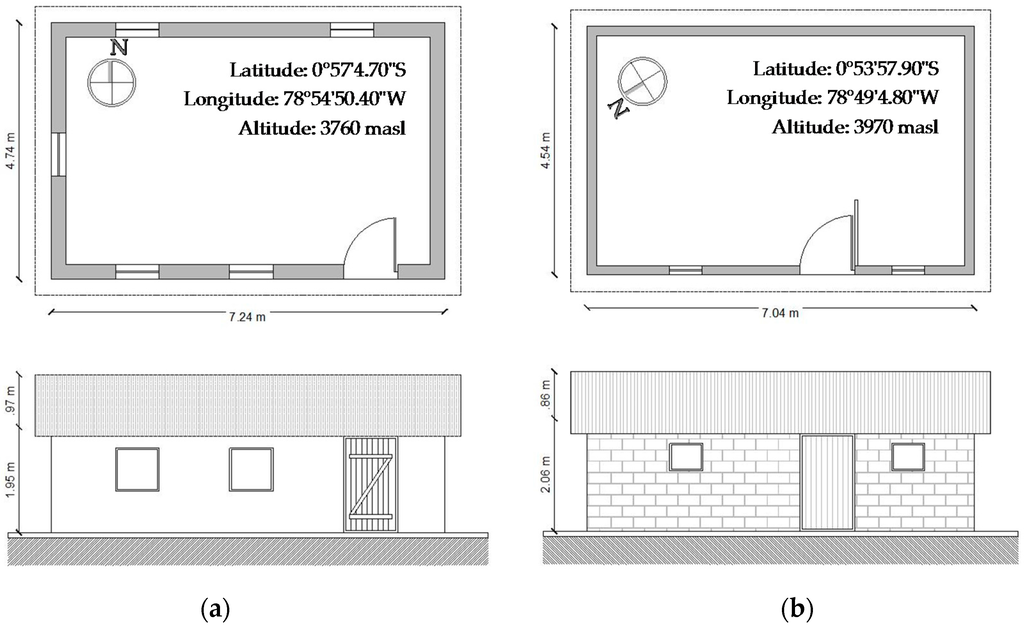
Figure 1.
Schema of the dwellings locations and dimension. (a) Case A; and (b) Case B.
3. Methodology
In order to assess the indoor environment in low-cost rural housing, the research was divided into three stages a) field data collection, b) building modelling and calibration, and c) comparison analysis and assessment of traditional improvement strategies. Observation and interview methods were used for the collection of qualitative data regarding the households, with field measurements performed using data loggers for the collection of quantitative data. The data collected were used to create and validate the building model in EnergyPlus (v8.1, NREL, Golden, CO, USA) [13]. Then, through the validated model, building thermal simulations were conducted to perform the strategies assessment, where the implementation of vernacular passive strategies was analysed.
3.1. Data Collection
Qualitative and quantitative data were collected during the field research. The implemented qualitative techniques were observation and open-ended questions. Three visits were conducted within the data collection period. A direct observation method in natural settings was used to collect data regarding construction issues and householder’s behaviour. In addition, open-ended questions were conducted with practitioners from the NGO and householders. The queries formulated on the interviews were non-directive and varied according to the participants. Householders were encouraged to talk about housing using profiles and activities, whereas practitioners were asked about the design and construction process. Construction documents and technical specifications were also collected and analysed. Data from observation and interviews were combined to create the household profiles, identify the householders’ thermal perception, and recognise lifestyle patterns.
On the other hand, indoor and outdoor dry bulb temperatures were collected within a week of the dry period in both dwellings, from 5–12 June 2011. These variables were measured with a HOBO U12-012 Data Logger (Onset Computer Corporation, Bourne, MA, USA) in a time lapse of 10 minutes.
3.2. Building Modelling
The qualitative and quantitative data collected and processed from the field research were used as the input data for the building modelling of the two case studies. Building geometry, internal heat gains, and usage profiles were defined according to the data collected. The model is comprised of a single thermal zone which represents the original configuration of the open space. The parameters of the fabrics were selected from several resources. The thickness of the different construction layers was defined through site measurements and as-built documentation. Likewise, the thermal properties of generic materials, such as concrete, zinc, and wood, were set according to the software database [14] while specific materials, like CSEB, were defined according to the literature review [15,16,17].
3.2.1. Weather Data
Hourly measured climate data file of the particular location where monitor houses are located was not available. However, based on a study of Ecuadorian climate zoning [18], Zumbahua is located in Zone 4 (M121). Therefore, the input weather file used in this study was the corresponding to the Cotopaxi mountain base camp station, which is located in the same climatic zone.
3.2.2. Building Data and Constructions
The dwelling’s geometry, orientation, as well as its openings, were modelled according to the data collected on site. Additionally, the effect of external shading elements and land levels were represented through component blocks. The construction details with associated U-values for Cases A and B were set according to the Table 1.

Table 1.
Case A and Case B envelope materials.
3.2.3. Internal Heat Gains
The internal heat gains in the models are occupancy and artificial lighting, while a gas stove in Case B was the only appliance observed. The internal heat gains and schedules for Cases A and B are summarised in Figure 2. Artificial lighting was supplied by two incandescent light bulbs, leading to an internal heat gain of 6.4 W/m2. The heat gain of a gas range (102 W/m2) [19] was added to the Case B considering a latent fraction of 34% [14]. It should be emphasised that the studied dwellings, as usual in the region, are not mechanically conditioned. Hence, there is no heating nor cooling system installed. The number of occupants and the usage schedules are the main difference on occupancy between the two case studies. Case A presents a three-user nocturnal occupation, while a four-member family occupied Case B through the afternoon and over the night-time.
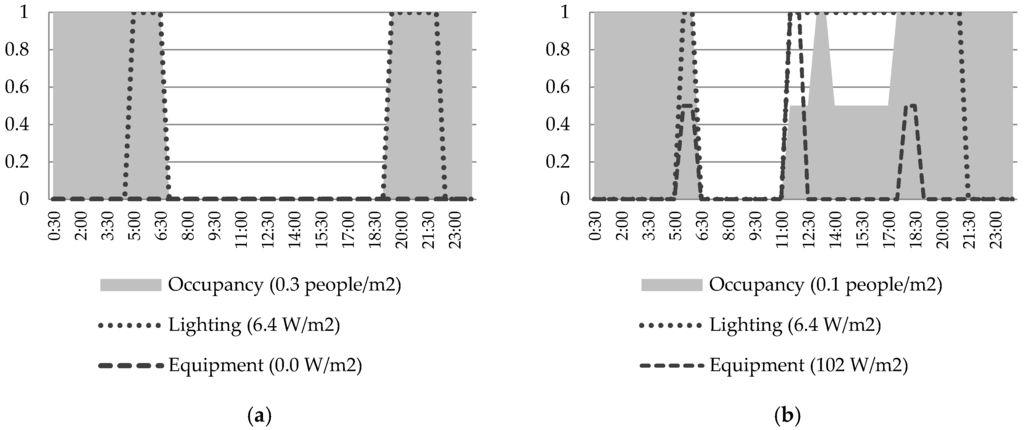
Figure 2.
Internal load schedules (a) Case A internal loads; and (b) Case B internal loads.
3.2.4. Infiltration
The infiltration was modelled by considering the calculated ventilation mode, where the natural ventilation and infiltration air rate (m3/h-m2 at 50 Pa) are calculated based on opening and crack sizes, buoyancy, and wind pressure. The dwelling was set as exposed to the wind, affecting in this way the pressure coefficients for natural ventilation and the calculation of U-values. As a consequence of several cracks in the dwelling envelope observed in the case studies, this parameter was specified as very poor (25 m3/hr-m2 rate at 50 Pa) [20].
3.2.5. Model Calibration
In order to get reliable thermal performance predictions, the building model was adjusted through a calibrated data-driven approach using indoor and outdoor dry-bulb temperature data collected under typical operation conditions. Firstly, the weather file of Cotopaxi was modified by replacing the values of the observed outdoor temperature. The hourly observed temperature values, of each day of measurement, were replaced on the days of the weather file that meet the following two conditions: (a) the minimum root mean square error RMSE between the hourly outdoor temperature (observed vs. weather data) and, (b) the day with the lower cumulative value of direct normal irradiance (DNI) from the weather file. Then, unlike other calibration methodologies that consider energy use [21] and daily temperature values [22], the hourly temperature values were used for the model calibration on this study. The precision of the comparison between the predicted and the observed indoor air temperature was evaluated through the following statistical analysis: (a) the coefficient of determination (R2), (b) the root mean square error (RMSE), and (c) the interquartile temperature distribution.
3.3. Comparison Analysis and Traditional Strategies Implementation
The actual thermal behaviour of the two observed case studies (Case A and Case B) diverge not only due to envelope materials, but also due to differences in orientation, geometry, window to wall ratio (WWR), and internal heat gains. Hence, it would be inappropriate to directly compare Case A and Case B, since variables other than envelope materials may have a high impact on the indoor thermal performance. Consequently, two hypothetical models (Case C and Case D) were proposed in which only the envelope materials differ from each other. Thus, Case C corresponds to a dwelling modelled with the same envelope materials as Case A (traditional materials) and Case D to a dwelling modelled with the envelope materials as Case B (common practice fabrics). The geometry, orientation and WWR in Case C and Case D were set up as identical to Case A, whereas internal heat gains and schedules were set according to Case B. The reasons behind these selections are the north-south dwelling orientation and the increased glazing surface on opposite facades in Case A, and the regular occupancy patterns in Case B. The north-south orientation and increased window surface allows the improvement of indoor air quality through the enhancement of natural lighting, as well as the effectiveness of natural ventilation strategies. Likewise, the internal heat gains and the daily operational schedules in Case B reflect the common usage conditions of rural housing in the region.
Finally, to assess the influence of the envelope materials on the indoor thermal performance, an annual simulation was conducted. A weekly heat balance analysis for a typical week with high and low DNI was carried out to identify the envelope critical elements. The strategies to improve the indoor thermal performance were established for the critical elements according to a systematic review of traditional housing design practices in the Andes Region. The criteria for strategies selection are low-cost, simplicity, and applicability to existing buildings. The effectiveness of the implemented strategies was assessed through the indoor air temperature range.
4. Results and Discussion
4.1. Observed Data Analysis
The observed indoor temperature data from Case A and Case B were compared with the observed outdoor dry bulb temperature. Frequency distribution and linear regression are the statistical methods used for comparing the two data sets. The temperature range in Case B (14.8 °C) is similar to the outdoor temperature range (14.7 °C) while Case A (10.1 °C) shows a higher thermal stability with a reduction of 4.7 °C in the total temperature oscillation (Figure 3). In the same way, the interquartile range of Case B is wider than the interquartile range of Case A by 2 °C. Accordingly, the results of previous studies evidenced that traditional dwellings, due to the thermal mass and insulation properties of the materials, perform substantially better than uninsulated hollow concrete block dwellings [9].
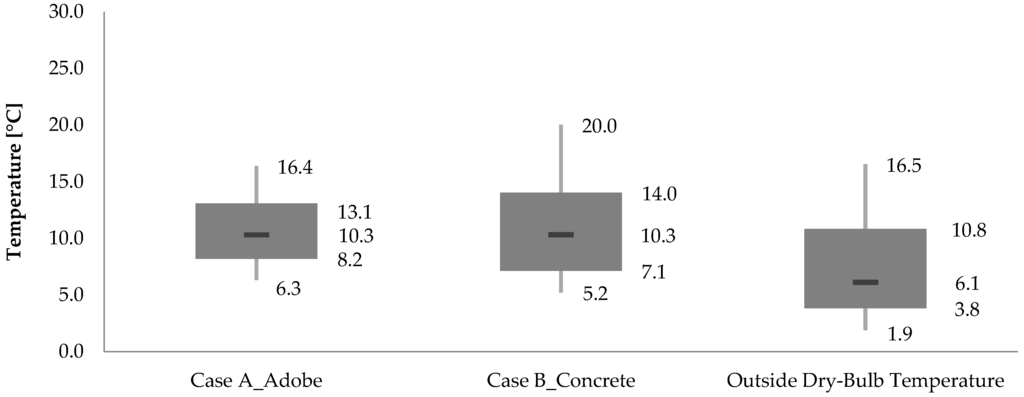
Figure 3.
Observed temperature maximum, minimum, and interquartile range distribution.
The lowest indoor temperature for Case A (6.3 °C) occurs one hour after the outdoor minimum (1.4 °C). Likewise, the maximum indoor temperature (17.3 °C) happens 2.5 hours after the highest measurement on the second day (14.2 °C). On the other hand, Case B achieves the minimum temperature (5.2 °C) just ten minutes after the lowest outdoor temperature. The same shifts behaviour was observed regarding the maximum indoor temperature during the second and third day of measurements as shown in Figure 4. This displacement of the peak temperatures is a reflection of the building envelope heat capacity. The envelope heat stability expressed as an index of the diurnal indoor to outdoor temperature fluctuation (Δti/Δto) [23], is 0.6 in Case A and 1.3 in Case B.
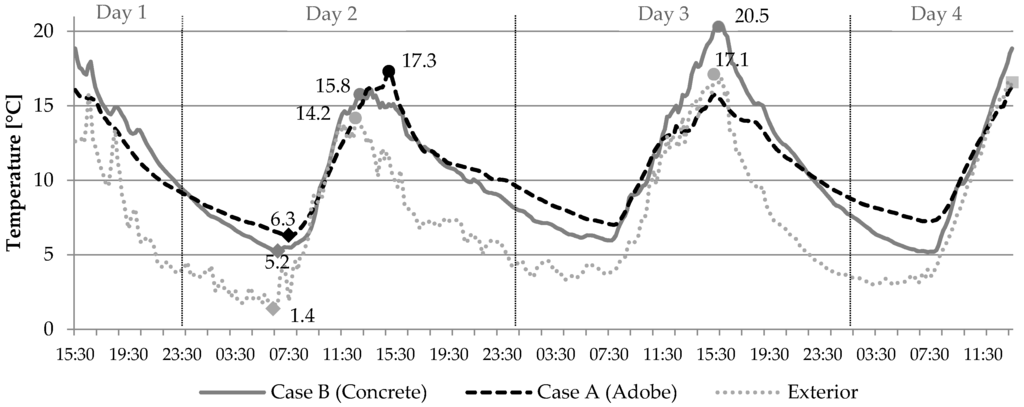
Figure 4.
Observed temperatures from Case A, Case B, and exterior.
In order to identify the impact of outdoor temperature on the indoor environment the coefficient of determination (R2) was calculated. A higher value for Case B (0.83) was identified in comparison to Case A (0.79). This means that the outdoor temperature has more effect on the indoor temperature for the uninsulated dwelling. A detailed correlation analysis was developed with the data aggregated over three hours. The highest correlation between the indoor and outdoor temperature was observed in the concrete dwelling within the day-occupancy hours, between 9:00 to 12:00 (0.82) and 15:00 to 18:00 (0.96). At noon (12:00 to 15:00), the R2 is lower (0.69) denoting the influence of other external parameters. During the occupancy period in the concrete house, the door remains open, due to low-lighting levels and the cultural habit of maintaining direct contact with the exterior. Therefore, the resulting high R2 value can be associated with high air change rates as a result of householders’ habits. On the other hand, opposite than expected, during night time, there is no apparent correlation between indoor and outdoor temperature. A continuous decrease in the indoor temperature is observed, but this diminishing is not correlated with the external temperature behaviour. Hence, other parameters, such as infiltration, can be the cause for the low correlation between temperatures, considering that the primary source of internal heat gains is occupancy.
4.2. Building Model Calibration
A high correlation between the observed and predicted data was achieved after slight iterations on the infiltration rate (between medium, poor, and very poor airtightness levels) and the variation of CSEB properties according to the parameters identified in the literature. The thermal properties that allow the best recreation of the indoor temperature behaviour in Case A are the ones stated by Allinson [15]. The R2 between the observed and predicted data is 0.89 in Case A and 0.94 in Case B, whereas the error (RMSE) is 1.1 °C for both cases. The indoor maximum and minimum peak values were not precisely achieved at the calibrated model as shown in Figure 5.
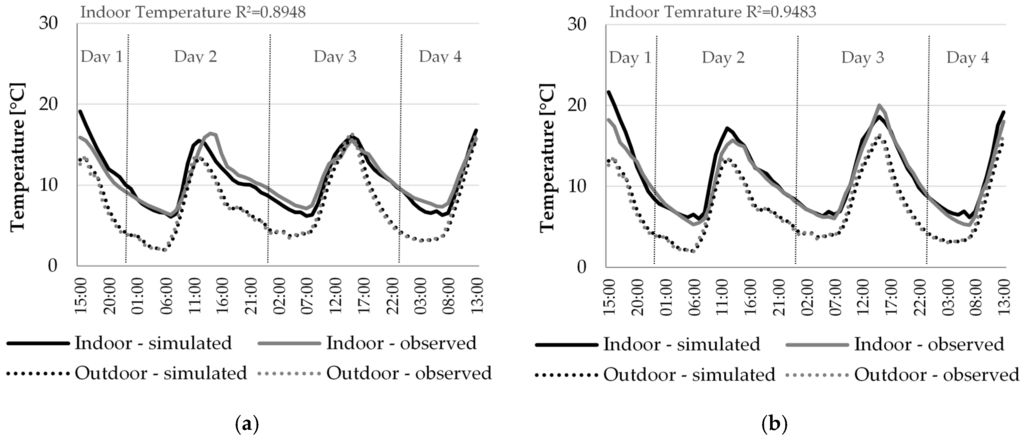
Figure 5.
Indoor and outdoor dry bulb temperature plots of observed and predicted data; (a) Case A; and (b) Case B.
The main error identified in the model occurs in the first day of measurement, where the DNI is greater than twice the value of the irradiance registered in the weather file for the other three days. This effect can be particularly noticed at noon, where the sun achieves its highest position.
4.3. Comparative Analysis
During the whole year, the dry outdoor temperature remains stable because of the geographic location. The average daily temperature (based on the annual hourly data) is 8 °C (SD 1.19 °C) while the average daily temperature range (Tmax–Tmin) is 8.15 °C (SD 4.33 °C). These values show that the average temperature remains stable throughout the year, contrary to the daily temperature oscillations which are higher. Figure 6 shows the hourly average values of heat exchange of the different envelope elements for a week with high DNI. Even though the glazing surface is increased in Case C and Case D compared to Case B, the gains and losses of heat through the windows are minimal. Evidence of vernacular architecture reports the usage of wood shutters over the windows as a mechanism that provides security, privacy, and solar control. In addition, these traditional elements, commonly used during the night time, could improve the windows’ insulation properties. A higher thermal stability of earthen materials can be noticed at night, when compared to the performance of hollow concrete block. Likewise, during the daytime, the effect of solar radiation over the envelope is evident in the roof’s surfaces (36.40 m2) even though the walls have a larger exposed surface (50.40 m2). The roofing elements show a higher thermal exchange with the environment in consequence of solar radiation. Additionally, it is noticed that, in addition to the roof, the most critical parameters are the flooring and the external infiltration. The high air leakage rates are a result of the self-build process and poor construction quality. Moreover, the isolated location of dwellings aggravates this condition due to direct exposure to wind. Therefore, the high wind exposure and the poor construction quality provoke high rates of external infiltration and high dependence of the indoor temperature on external conditions. Thus, the unintended introduction of cold outdoor air decreases the indoor temperature levels.
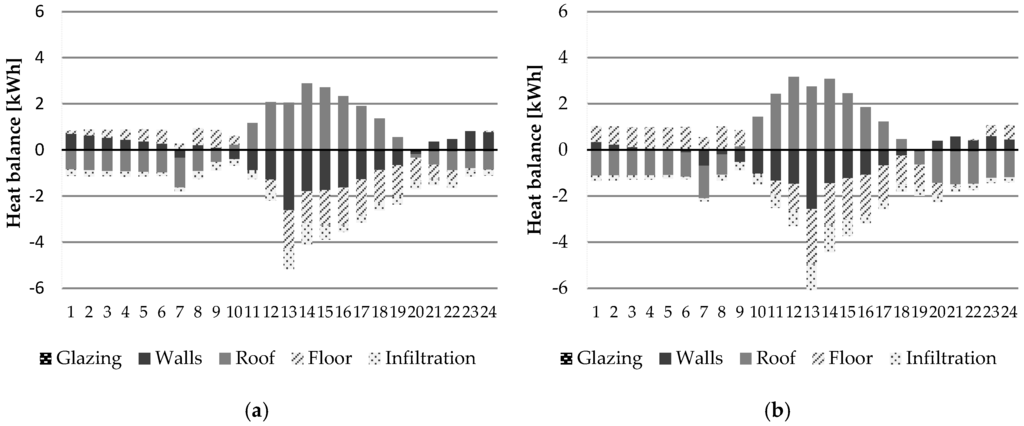
Figure 6.
Dwellings envelope heat balance for a week with high DNI; (a) Case C—earthen envelope heat balance; and (b) Case D—concrete envelope heat balance.
From the three critical parameters identified, the ones that can be easily improved in existing dwellings are the roof and the air permeability. In order to use strategies that preserve the traditional architecture, a review of vernacular construction techniques was conducted. One of the identified technologies is the use of a ceiling made of “carrizo” (local wood species) covered with earthen plaster (timber infill) [24]. The implementation of the ceiling will reduce the volume of air to be conditioned. However, some constructive adaptations should be considered to guarantee the minimum floor-to-ceiling height requirements as stipulated in the local regulations [25]. Therefore, the selected strategies are the traditional ceiling of timber infill with earth, and the improvement of the dwelling airtightness to a medium level. As shown in Figure 7, through the implementation of these strategies (Case C_opt and Case D_opt), the range of the indoor temperatures are respectively increased by 4.2 °C and 3.9 °C compared to Case C and Case D. Despite the considerable increase in the indoor temperature, the upper quartile range does not exceed 16 °C, which allocates over 75% of the total hours under the range of adaptive thermal comfort [26]. Nevertheless, this comfort range may not represent a basis for thermal comfort in the Andes Region. As reported by Huang et al. [8], the perceived comfortable temperature is strongly affected by occupants’ clothing, lifestyle, and adaptation to the local context. Indeed, according to the qualitative analysis data, the users perceive the average indoor environment as comfortable or slightly cold despite the low indoor temperature. Furthermore, under rare circumstances, the indoor temperature can reach 34 °C. These occasional peaks are mainly a consequence of direct solar radiation and not due to high outdoor temperature. Therefore, natural ventilation strategies could be implemented to prevent these occasional peaks taking advantage of the difference between the indoor and outdoor temperature.
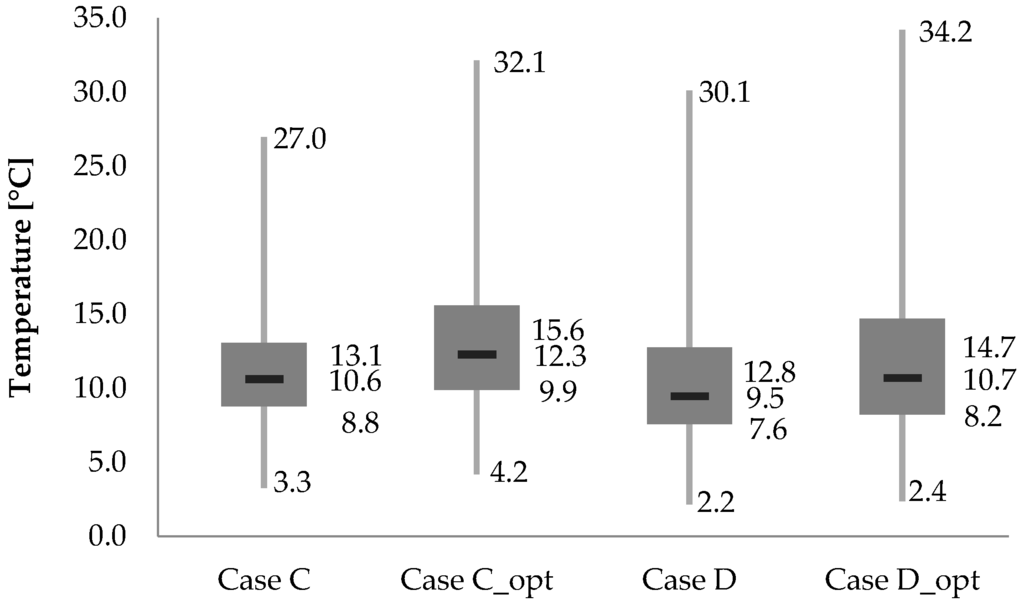
Figure 7.
Predicted indoor temperature.
5. Conclusions
The aim of this research was to assess the influence of the critical building parameters on the indoor thermal performance in rural housing in the Ecuadorian Andes. The study was conducted in three stages: data collection, building modelling, and improvement strategies assessment. During the data collection phase, the contact with the community through a local interlocutor was mandatory to gain access to dwellings and people in the community of Zumbahua. Qualitative and quantitative data regarding the housing usage and construction technology were gathered and used as input data to calibrate the thermal building models. The observed data evidenced a higher thermal stability of the traditional dwelling (Case A), with a reduction of 4.7 °C in the total temperature oscillation, compared to Case B (14.8 °C), where the temperature range is similar to the outdoors (14.7 °C). However, a longer measurement period is highly recommended to assess the dwellings behaviour under extreme conditions of temperature and solar radiation. In the same way, real measured data of the environmental conditions would provide a better understanding of the housing behaviour.
A high precision was achieved for calibration of the thermal models, whereas the reached correlation (R2) between the observed and predicted data is 0.89 in Case A and 0.94 in Case B. As for the building energy simulation, the modelling accuracy relies on the precise characterisation of energy use. The calibration of a thermal model will depend on the building description and weather data. Therefore, as it has been noticed, the infiltration rate and the material thermal properties are the parameters with more uncertainty due to the lack of on-site measurements. Hence, it is highly recommended to determine theses values with a higher accuracy in future experiments.
The thermal simulation results show that the roof, floor and the airtightness are the critical building parameters in Case C and Case D. However, the assessment of potential strategies may be limited to the ones that can be easily implemented in the refurbishment of existing dwellings. Therefore, through the use of passive strategies, such as traditional ceiling and the improvement of airtightness, the average indoor temperature raises up to 2 °C in Case C and Case D. These results agree with previous studies that show earthen constructions having a higher thermal stability among uninsulated lightweight systems. Finally, although 75% of the hours the indoor temperature is below an acceptable thermal comfort range, no change in users’ attitude was noticed during the field research. Consequently, future research should be conducted to better understand population thermal comfort adaptability in the Ecuadorian highlands.
Acknowledgments
The authors would like to acknowledge the financial support provided by the National Secretary of Higher Education, Science, Technology and Innovation (SENESCTY). Furthermore, the research team is thankful for the technical support and resource coordination received by Fundación Ecuatoriana del Hábitat (FUNHABIT) and the families that participated in the data collection process and interviews.
Author Contributions
The study was conceived, designed and performed by Isabel Mino-Rodriguez. A contribution to data analysis and paper writing was done by Carlos Naranjo-Mendoza and Ivan Korolija.
Conflicts of Interest
The authors declare no conflict of interest.
References
- UN Habitat. The Right to Adequate Housing; United Nations: Geneva, Switzerland, 2009; Volume 21, p. 59. [Google Scholar]
- Bouillon, P. Un espacio para el desarrollo: los mercados de vivienda en América Latina y el Caribe; Inter-American Development Bank: Washington, DC, USA, 2012; pp. 68–96. [Google Scholar]
- Libertun de Duren, N.; López Lamia, A.; Brakarz, J.; Marcano, L.M.; Román- Sánchez, S.; Alemán, M.; De la Bastida, J.L.; Campillo, G.; Escobar, X.; Lugo, M.; et al. National Social Housing Program—Stage II; Inter-American Development Bank: Washington, DC, USA, 2012. [Google Scholar]
- Instituto Nacional de Estadística y Censos. Available online: http://www.ecuadorencifras.gob.ec/ (accessed on 22 April 2015).
- Instituto Nacional de Estadística y Censos (INEC). Condiciones de Vida de los Ecuatorianos—Vivienda; INEC: Quito, Ecuador, 2006. [Google Scholar]
- Marincic, I.; Ochoa, J.M.; Alpuche, M.G.; González, I. Comparative analysis of the thermal behavior between cellular concrete blocks and stabilized earth blocks as wall materials. Energy Procedia 2014, 57, 1783–1791. [Google Scholar] [CrossRef]
- De Dear, R.J.; Brager, G.S. Thermal comfort in naturally ventilated buildings: Revisions to ASHRAE Standard 55. Energy Build. 2002, 34, 549–561. [Google Scholar] [CrossRef]
- Li, H.; Zhu, Y.X.; Ouyang, Q.; Cao, B. Measurement and field survey of indoor thermal comfort in rural housing of northern China in winter. J. Southeast Univ. 2009, 1, 245–251. [Google Scholar]
- Palme, M.; Guerra, J.; Alfaro, S. Thermal performance of traditional and new concept houses in the ancient village of San Pedro de Atacama and surroundings. Sustainability 2014, 6, 3321–3337. [Google Scholar] [CrossRef]
- Dear, K.B.G.; McMichael, A.J. The health impacts of cold homes and fuel poverty. BMJ 2011, 342, d2807. [Google Scholar] [CrossRef] [PubMed]
- Maidment, C.; Jones, C.; Webb, T.; Hathway, A.; Gilbertson, J. The impact of household energy efficiency measures on health: A meta-analysis. Energy Policy 2014, 65, 583–593. [Google Scholar] [CrossRef]
- Ormandy, D.; Ezratty, V. Health and thermal comfort: From WHO guidance to housing strategies. Energy Policy 2012, 49, 116–121. [Google Scholar] [CrossRef]
- USA Department of Energy. In EnergyPlus: Energy Simulation Software. Available online: https://energyplus.net/ (accessed on 30 August 2016).
- ASHRAE. Handbook Fundamentals; American Society of Heating, Refrigerating and Air-Conditioning Engineers: Atlanta, GA, USA, 2009; Volume 30329. [Google Scholar]
- Allinson, D.; Hall, M. Hygrothermal analysis of a stabilised rammed earth test building in the UK. Energy Build. 2010, 42, 845–852. [Google Scholar] [CrossRef]
- Adenaike, F.A. Brickyard practises in Nigeria: Improving the compressive strength of cement stabilised earth bricks through soil. IJSER 2015, 6, 1235–1242. [Google Scholar]
- Adam, E.; Agib, A. Compressed Stabilised Earth Block Manufacture in Sudan; UNESCO: Paris, France, 2001. [Google Scholar]
- Mino-Rodriguez, I.; Gaona, G.; Lobato, A.; Naranjo-Mendoza, C.; Labus, J. Implementation of GIS methodology and passive strategies to improve the quality of social housing in the Andean region of Ecuador. World Sustain. Build. 2014, 3, 148–156. [Google Scholar]
- McMullan, R. Environmental Science in Building, 7th ed.; Palgrave macmillan: Basingstoke, UK, 2012. [Google Scholar]
- EnergyPlus. Engineering Reference. The Reference to EnergyPlus Calculations. Available online: http://infohouse.p2ric.org/ref/36/35821.pdf (accessed on 30 August 2016).
- Coakley, D.; Raftery, P.; Keane, M. A review of methods to match building energy simulation models to measured data. Renew. Sustain. Energy Rev. 2014, 37, 123–141. [Google Scholar] [CrossRef]
- Paliouras, P.; Matzaflaras, N.; Peuhkuri, R.H.; Kolarik, J. Using measured indoor environment parameters for calibration of building simulation model—A passive house case study. Energy Procedia 2015, 78, 1227–1232. [Google Scholar] [CrossRef]
- Martín, S.; Mazarrón, F.R.; Cañas, I. Study of thermal environment inside rural houses of Navapalos (Spain): The advantages of reuse buildings of high thermal inertia. Constr. Build. Mater. 2010, 24, 666–676. [Google Scholar] [CrossRef]
- Carnevale, E.; Rakotomamonjy, B.; Sevillano Gutiérrez, E.; Abad Rodas, M. de L. Orientaciones para la conservación de inmuebles patrimoniales de Tierra en Cuenca; UNESCO: Cuenca, Ecuador, 2015. [Google Scholar]
- Municipio del Distrito Metropolitano de Quito (DMQ). Normas de Arquitectura y Urbanismo; Concejo Metropolitano de Quito: Quito, Ecuador, 2003. [Google Scholar]
- Nicol, J.F.; Humphreys, M.A. Adaptive thermal comfort and sustainable thermal standards for buildings. Energy Build. 2002, 34, 563–572. [Google Scholar] [CrossRef]
© 2016 by the authors; licensee MDPI, Basel, Switzerland. This article is an open access article distributed under the terms and conditions of the Creative Commons Attribution (CC-BY) license (http://creativecommons.org/licenses/by/4.0/).